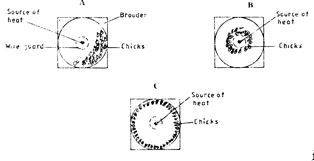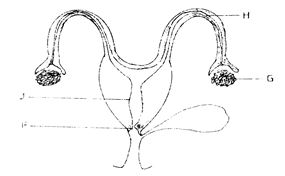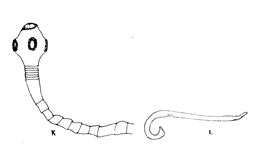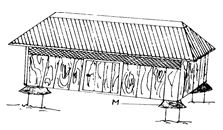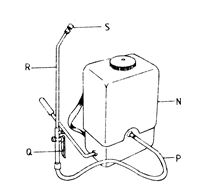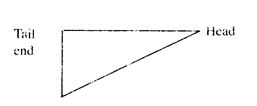QUESTIONS
SECTION A (30 marks)
Answer all the questions in this section in the spaces provided.
- Name causal agent of anaplasmosis disease in cattle. (½ mks)
- List four materials that can be used in constructing a Kenya Top Bar Hive. (2mks)
-
- Name two breeds of dairy cattle that originated from the Channel Islands. (1mk)
- Give the distinguishing colour for each of the following breeds of livestock:
- chinchilla rabbit; ( ½ marks)
- toggenburg goat. ( ½ mks)
- State four reasons for castration in pig production. (2mks)
- State four characteristics of roughage livestock feeds. (2mks)
- State two functions of the crop in poultry digestive system. (1mk)
- State four roles of worker bees in a colony. (2mks)
- Give four reasons for controlling livestock diseases. (2mks)
- State two control measures for fowl pox disease in poultry. (1mk)
- State one function for each of the following:
- shovel ( ½ mark)
- strip cup ( ½ mk)
- Give three reasons for carrying out maintenance practices on a mower. (1½ mks)
- Give three limitations of using solar power on the farm. (1½ mks)
- Why is it important to have a thermostat on a cooling system of a tractor engine?(1mk)
- Give two advantages of using a disc plough over a mouldboard plough in primary cultivation. (1mk)
- Name four tools that are used when laying concrete blocks during construction of a wall. (2mks)
- Why is it necessary to have guard rails in a farrowing pen? (1mk)
- Give two reasons for having a footbath in a cattle dip. (1mk)
- Distinguish between the following practices as used in livestock production:
- crutching and ringing in sheep management (2mks)
- cropping and harvesting in fish farming. (2mks)
- Give three ways in which infectious diseases can spread from one livestock to another within a farm. (1½ mks)
SECTION B (20 marks)
Answer all the questions in this section in the spaces provided.
- The following illustrations show the behavior of chicks in a brooder. Study them carefully and answer the questions that follow.
insert diagram)- Explain the cause of behavior observed in chicks for each of the illustrations labeled A, B and C. (3mks)
- Give a reason for making the brooder wall round in shape. (1mk)
- The diagram below shows the reproductive system of a cow. Study it carefully and answer the questions that follow.
- Name the parts labeled F and H. (1mk)
- Give two functions of the part labeled G. (2mks)
- Give the role of the part labeled J. (1mk)
- Below are diagrams of internal parasites. Study them carefully and answer the questions that follow.
- Identify the parasites labeled K and L. (1mk)
- Name the developmental stage of the parasite labeled K in cattle muscles.( ½ mark)
- Outline the procedure of handling a heifer when administering a liquid deworming drug to control the parasites illustrated above. (2½ mks)
- Below is a diagram of a farm structure for storing grains. Study it carefully and answer the questions that follow:
- Identify the farm structure illustrated above. (½ mark)
- State the function of the part labeled M. (½ mk)
- State two maintenance practices that should be carried out on the farm structure illustrated above in readiness for grain storage. (1mk)
- Below is a diagram of a knapsack sprayer. Study it carefully and answer the questions that follow:
- Name the parts labeled N, P, Q and R. (2mks)
- State one function of the part labeled S. (1mk)
- The diagram below illustrates the general shape of a cattle breed. Study it carefully and answer the questions that follow:
- Identify the type of breed illustrated by the above shape. (½ mk)
- Give an example of a breed in (a) above. (½ mk)
- State four physical characteristics of the type of breed identified in (a) above. (2mks)
SECTION C (40 marks)
Answer any two questions from this section in the spaces provided after question 28.
-
- Outline five advantages of artificial insemination in cattle management.(5mks)
- Describe ten signs of trypanosomiasis (Nagana) disease in livestock.(10mks)
- Explain five functions of water in nutrition. (5mks)
-
- State the function of any six parts of a zero grazing unit in dairy farming.(6mks)
- Explain how the power transmitted from a tractor engine is made available for use on the farm under the following subheadings:
- propeller shaft (2mks)
- power take off (P.T.O.) shaft (2mks)
- hydraulic system. (2mks)
- Explain eight ways in which ticks can be controlled on a livestock farm.(8mks)
-
- Describe ten physical characteristics a poultry farmer would use to identify poor layers from a flock of hens. (10mks)
-
- Outline three characteristics of clean milk. (3mks)
- Explain seven factors that affect milk composition in dairy farming. (7mks)
MARKING SCHEME
- Causal agent of anaplasmosis disease in cattle
- Protozoa/anaplasma marginate/anaplasma spp. (1 x 1/2 = 1/2 mark)
- Materials used in constructing a Kenya Top Bar Hive (K.T.B.H)
- Timber
- Nails
- Plain wire
- Iron sheets (4 x 1/2 = 2 marks)
-
- Breeds of dairy cattle that originated from the channel islands:
- Guernsey
- Jersey (2 x 1/2 = 1 mark)
-
- Chinchilla rabbit
- Grey/silvery (1 x 1/2 = 1/2 mark)
- Toggenburg
- Brown with two white stripes running down the face (1 x 1/2 = 1/2 mark)
- Chinchilla rabbit
- Breeds of dairy cattle that originated from the channel islands:
- Reasons for castration
- Prevent uncontrolled mating/breeding
- Improve the quality of meat
- Promote faster growth/facilitate weigh gain
- Make then docile
- Control breeding diseases
- Control inbreeding (4 x 1/2 = 2 marks)
- Characteristics of roughages
- Bulky
- High fibre content
- Low nutrient content
- Low digestibility
- Mainly of plant origin (4 x 1/2 = 2 marks)
- Functions of the poultry digestive system.
- Softening/moistening food
- Temporary food storage (2 x 1/2 = 1 mark)
- Roles of worker bees kills.
- Kills the drones after mating the queen
- Scouting for a new home
- collect nectar/water/gum/propolis/pollen
- Make honey combs
- Protect the colony
- Clean the hive
- Make honey and bees wax
- Seal the stacks and services (4 x 1/2 = 2 marks)
- Reasons for controlling livestock diseases.
- Reduces spread of livestock diseases/production of healthy young ones
- Promote fast growth and early maturity - rej to maintain good health in livestock
- Make them have long productive life.
- Improve quality and safety of products
- Improve quantity of products
- Reduce cost of production. (4 x 1/2 = 2 marks)
- Control measures of fowl pox diseases in poultry.
- Observe hygiene in poultry house
- Regular vaccination
- Slaughter and properly dispose carcass of affected birds - rej culling, killing atone(2 x 1/2 = 1mark)
-
- shovel
- Mixing mortar/manure
- Lifting soil/manure (1 x 1/2 = 1/2 mark)
- Strip cup
- To detect mastitis infection in milk. (1 x 1/2 = 1/2 mark)
- shovel
- Reasons for maintenance practices.
- For safety of the user/operator
- Ensure efficiency of operations
- Increases durability
- Reduces costs on repairs and replacements
- Avoid damage to the mower. (3 x 1/2 = 11/2 marks)
- Limitations of using solar power
- Solar trapping devices are expensive
- Power supply/trapping fluctuates depending on weather conditions
- Solar trapping is limited to day light
- Requires skilled labour to handle the devices (3 x 1/2 = 11/2 mark)
- Importance of thermostat
- Prevents engine from over-heating
- Maintains optimum engine temperature during operation (1 x 1 = 1 mark)
- Advantages of disc plough over a mould board plough
- Discs roll over obstacles
- Requires less draught power
- Requires less maintenance costs
- Works better on dry, hard and sticky soils (2 x 1/2 = 1mark)
- Tools used when laying concrete blocks during construction of a wall.
- Plumb bob/plumb line
- Mason’s trowel
- Spirit level/pipe level
- Wood float/steel float
- Masons square
- String/masons line/line (4 x 1/2 = 2 marks)
- Importance of guard rails in a farrowing pen.
- Prevents sow from crushing piglets rej. trampling of piglets
- Prevents sow from eating creep feeds (1 x 1 = 1 mark)
- Reasons for having foot bath in a cattle dip.
- Clean the feet of animals
- Control foot rot (2 x 1/2 = 1 mark)
-
- Crutching and ringing
- Crutching is the cutting of wool around the external reproductive organs of a female sheep to facilitate mating
- Ringing is the cutting of wool around the sheath of the penis in rams to facilitate mating. (Mark as a whole 2 marks)
- Cropping and harvesting
- Cropping is the selective removal of fish of marketable size from the pond.
- Harvesting is the removal of all the fish from the pond. (Mark as a whole 2 marks)
- Crutching and ringing
- Ways in which infectious diseases can spread
- through vectors
- through ingestion of contaminated food and water/through food and water
- Through contact
- Through inhalation of contaminated air/through air. (3 x 1/2 = 11/2 marks)
-
- Causes of chicks’ behaviour in the illustrations A, B and C
- A Presence of draught makes the chicks to crowd on one side of the brooder
- B Cold/inadequate heat makes the chicks to crowd around the heat source
- C High/Excess heat makes the chicks to move away from the heat source (3 x 1 = 3 marks)
- Reasons for making brooder wall round in shape
- To discourage overcrowding of chicks at the corners to avoid suffocation. (1 x 1 = 1 mark)
- Causes of chicks’ behaviour in the illustrations A, B and C
-
-
- F - Cervix
- H - Oviduct/Fallopian tube (2 x 1/2 = 1 mark)
- Presence of part labelled G
- Produces ova/female gametes
- Products hormones that control ovulation cycle/estrogen cycle 2 x 1 = 2 marks
- Role of J
- Allows implantation of the zygote and development of the foetus.
- Contracts to expel foetus
- Implantation of the foetus (1 x 1 = 1 mark)
-
-
-
- K - Beef tapeworm/Taenia saginata/Taenia spp rej tapeworm
- L - Roundworm/Ascaris lumbricodes/Ascaris spp (2 x 1/2 = 1 mark)
- Bladder worm/Embryo Cyst/Cystococus cellulase/cyst (1 x 1/2 = 1/2 mark)
- Procedure of handling a heifer when administering a liquid deworming drug.
- Restrain the heifer in a crush
- Hold it by the nostrils and lift up its head
- Open its mouth
- Release the drug into the mouth as far back as possible/place the drenching gun/bottle on the mouth
(Mark until the procedure is broken 21/2 marks
5 x 1/2 = 21/2 marks)
-
-
- Granary/modern store/crib (1 x 1/2 = 1./2 mark)
- Function of M
- Prevents entry of rodents into the store.
- To keep off vermins (1 x 1/2 = 1/2 mark)
- Maintenance practices on the structure
- repair and replace worn out parts
- Cleaning
- Fumigating/dusting with appropriate pesticides. (2 x 1/2 = 1 mark)
-
-
- N - Tank
- P - delivery note rej. hose pipe/hose alone
- Q - trigger
- R - Lance
- Function of S
- Breaks the liquid chemical into desired size of droplets/spray form/fume droplets/jets (1 x 1 = 1 mark)
-
-
- Dairy breed (1 x 1/2 = 1/2 mark)
- Friesian/Jersey/Guernsey/Ayrshire (1 x 1/2 = 1/2 mark)
- Physical characteristics of dairy cattle
- Wedge/triangular shaped
- Straight topline
- Large and well developed udders teats
- Prominent milk veins
- Lean bodies/thinly fleshed waters
- Large stomach
- small head and long neck
- Well set wide hind quarters
- Prominent/visible pin bones
- Long thin legs
-
- Advantages of artificial insemination
- Controls breeding diseases/parasites
- Controls breeding
- Is a quicker method of obtaining a proven bull
- Is easy and cheap to transport semen to far areas
- Semen from a superior bull can be used to serve many cows
- Farmers who cannot afford to buy a superior bull can access the service at a low cost
- Bulls that cannot serve naturally due to physically injuries/defects can be utilized.
- Prevents injuries to cows by heavy bulls
- Danger of injury/damage by aggressive bulls is eliminated
- Semen can be stored for a long period even after the death of the bull
- Saves the cost of rearing a bull
- Controls in breeding
- It is a useful research tool. (5 x 1 = 5 marks)
- Signs of Trypanosomiasis (Nagana) disease in livestock
- General body weakness/dullness
- Reduced milk production
- Swollen lymph nodes
- Rough coat and cracked skin where there is no hair
- Running eyes/lachrimation which can result in blindness/sunken eyes
- Diarrhoea
- Emaciation/loss of weight
- Loss of hair toward the tail end
- Abortion in pregnant females
- High fever/temperature
- Anaemia
- Loss of appetite
- Swollen parts of the belly (10 x 1 = 10 marks)
- Functions of water
- Component of body cells and many body fluids e.g blood
- Used in biochemical reactions in the body e.g digestion
- Regulates body temperature through sweating and evaporation
- Excretion of metabolic wastes from the body
- Formation of products e.g milk, eggs etc
- Makes cells turgid to maintain their shape.
- Transportation of nutrients from one part of the body to another (5 x 1 = 5 marks)
- Advantages of artificial insemination
-
- Use of the various parts of a zero grazing unit in dairy farming.
- Milk recording room - weighing and milking records
- Milking stall - rearing calf to weaning
- Calf pen - rearing calf up to weaning
- Sleeping cubicles - provide shelter and warmth
- Loofing area - dunging, feeding, exercise and sunning
- Feed and water troughs - feeding and watering the animals
- Feed preparation room - preparing feed rations and cropping fodder rej. chaff cutter region
- Store - storing/keeping dairy equipment/feeds
- Manure storage areas storing measure
Parts is tied to the function
6 x 1 = 6 marks
- How power transmitted from a tractor engine is made available for use on a farm.
- Propeller shaft
- connects gear box to the differential which has wheel axles
- Wheel axles rotate to move the tractor and push or pull trailed implements.
(2 x 1 = 2 marks)
- Power take Off (P.T.O) shaft
- Rotates at the same speed as the crankshaft.
- Its connected to machines e.g mowers, sprayers, shelters etc to perform farm operations (2 x 1 = 2 marks)
- Hydraulic system
- Is attached to the three-point linkage or attached on hydraulic mechanism trailer.
- the three point linkage operates (raises/lowers) the mounted implements during farm operations or for off loading (2 x 1 = 2 marks)
- Propeller shaft
- Ways in which ticks can be controlled
- Burning infested pastures to kill developmental stages. (1/2 mark for stating)
- Rotational grazing to starve and kill developmental stages. (1/2 mark)
- hand picking and killing the ticks.
- Fencing off pasture land and farm to keep away infested animals/double feeding re. fencing al
- Ploughing pasture land to burry and kill developmental stages.
- Top dressing pasture using lime to kill the ticks.
- Spraying using acaricides/had dressing/dipping to kill ticks.
- Use of natural enemies - eat the
- self licking - dislodges ticks from the body. (8 x 1 = 8 marks)
- Use of the various parts of a zero grazing unit in dairy farming.
-
- Characteristics of a poor layer.
- Combs and wattles - small/shrivelled/shrunken. dry scaly and place.
- eyes - dull and pale yellow.
- Beak - yellowish in colour.
- Abdomen/breast - hard and full
- Vent - round, dry and less active
- Space between keen and pelvic bone - small and fits only one or two fingers
- Plummage - preened & glossy (smooth) beautiful
- Moulting - early morning
- Shants/feet - Yellowish n colour
- Broodiness - Is common/early moulting
- Temperature - easy and dull
Mark as whole
Accept - poor layer is inactive. (10 x 1 = 10 marks)
-
-
- Free from disease causing micro-organisms/pathogens
- Free from hair, dirt or dust.
- Free from bad odours and tastes/has good flavours.
- Chemical composition within expected standards. (3 x 1 = 3 marks)
- Factors influencing milk composition
- Age of animal
Butter fat in milk becomes less as an animal grows old thus young animals produce milk with higher BF than older animals. - Breed differences rej. species of the animal
Different breeds of cattle produce milk with differing percentage composition e.g Jersey produce higher BF than Friesian. - Type of food eaten by an animal
Roughage feeds produce link with higher fats, lactose and protein compared to grains. - Diseases
Diseases such as mastitis reduce the lactose composition in milk because bacteria attack milk sugars. - Physiological condition of the animal.
Sick/extremely emaciated animals register low percentage of BF/during late pregnancy cows produce milk with low BF content. - Stage of lactation
The BF content in milk is highest at the middle phase of the lactation period and lowers towards end of lactation. - Completeness of milking
Milk drawn last from udder during contains high BF content/last drop milk has BF content produce in the milk. - Season of the year - accept environmental condition
BF content increases during cold seasons. - Time of milking
Milk produced in the morning has a lower BF content than milk produced in the evening
1/2 factor method
1/2 mk explanation (7 x 1 = 7 marks)
- Age of animal
-
- Characteristics of a poor layer.
Join our whatsapp group for latest updates
Tap Here to Download for 50/-
Get on WhatsApp for 50/-
Download KCSE 2010 Agriculture Paper 2 Questions with Marking Scheme.
Tap Here to Download for 50/-
Get on WhatsApp for 50/-
Why download?
- ✔ To read offline at any time.
- ✔ To Print at your convenience
- ✔ Share Easily with Friends / Students

